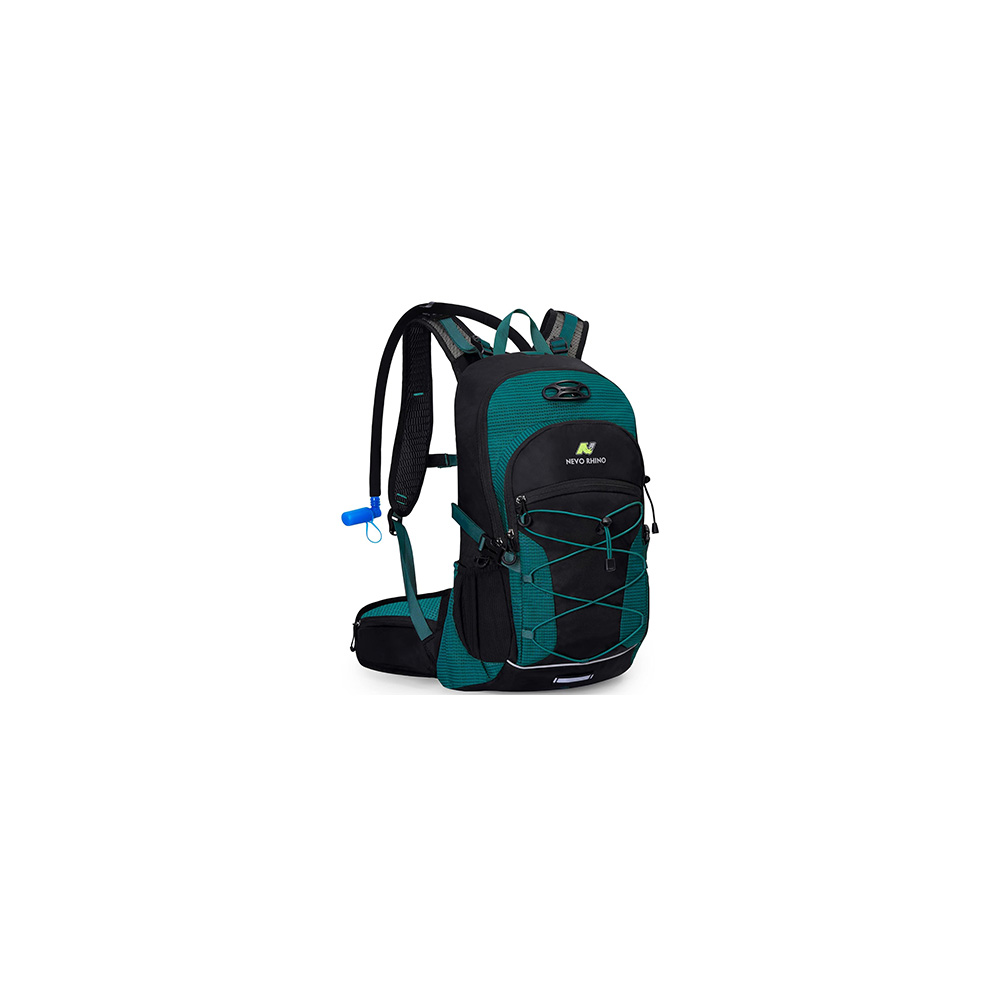
Quick Summary:
This guide provides step-by-step instructions. They are easy to follow. They explain how to adjust the straps of a ski rucksack with a hydration pack for comfort while skiing. Carrying a heavy ski rucksack can add up to 5 pounds of extra weight to your body. This weight hurts your skiing! Follow these steps to ensure a comfortable and enjoyable skiing experience.
Review of the Camelbak Powderhound 12
Locate the Shoulder Straps
To find the shoulder straps on the ski rucksack with the hydration pack, start by finding the padded straps. You should wear them over your shoulders. These straps are usually adjustable and will have a buckle or clip in the front for fastening. Trace the straps from where they attach near the top of the bag down to where they meet the main body of the rucksack. Remember, the shoulder straps are crucial. They balance the bag’s weight as you ski.
Adjust Shoulder Straps Length
Pull the change straps on the shoulder straps to make them shorter or longer. Do this according to your preference. Balance the straps on both sides with precision. This will ensure that you balance the weight on your shoulders. Find the desired fit by testing the length as you go. Make sure they’re both comfortable and secure for your activity. Put on the bag and refine the fit with precise measurements.
Chest Strap Adjustment
Position the chest strap across your chest ensuring it is snug. Pull the straps to adjust the length until you achieve a comfortable fit. Make sure the weight is even across your chest. This gives you the best support during your activity.
Hip Belt Adjustment
- Step 1: Place the hip belt around your waist, ensuring it sits comfortably on your hips.
- Step 2: Pull the loose end of the hip belt to tighten it until snug. The belt should rest above your hip bones.
- Step 3: Test the fit by carrying weight in the ski rucksack. If the belt digs into your skin, loosen it. If the bag sags, tighten it further.
- Step 4: Remember, a well-adjusted hip belt removes weight from your shoulders. It boosts your comfort while skiing.
Hydration Pack Positioning
- Place the hose of the hydration pack over your dominant shoulder. Place it firmly in the curve of your chest.
- Adjust the hose clip or magnetic tube trap to secure the hose within reach while skiing.
- Ensure no obstacles block the hose. Test the positioning by taking a few practice runs. Gain unrestricted access to it at all times.
Additional Strap Adjustments
Adjust any extra straps. This includes sternum straps and load lifters. Do this for the best comfort and weight distribution. Tighten or loosen the sternum strap. This keeps the shoulder straps in place and prevents them from moving side to side. Adjust the load lifters to pull the weight closer to your body. Spreading the weight across your back distributes it for better balance. Experiment with different settings. Do this until you find the most comfortable and supportive fit for your hike.
Testing Comfort and Fit
Put on the ski rucksack with the hydration pack. Adjust the straps around your shoulders and chest. Ensure the fit is snug and secure for a comfortable skiing experience. Adjust as needed until you achieve the right fit.
Final Checks
- Double-check all adjustments on your ski rucksack. Tighten the straps to ensure a snug and reliable fit.
- Tighten any loose straps to prevent shifting while skiing.
- Verify the ski rucksack’s snug back fit. This will prevent discomfort during your adventure.
- Take a moment to check all connections and buckles. Secure all equipment and clothing before descending the mountain.
Final Thoughts
Wrapping up. Adjust the ski rucksack straps. A hydration pack boosts your comfort level. It will also ensure better weight distribution when hitting the slopes. Happy skiing!
Essential gear list
Strap Adjustment Techniques
Steps for Properly Using Your Ski Rucksack with Hydration Pack
- When using a ski rucksack with a hydration pack, familiarize yourself with the gear first. Then, hit the slopes.
- Start by filling the hydration pack with water. Secure the seal to cut leakage possibilities.
- Adjust the straps of the rucksack to ensure a comfortable and secure fit while skiing.
- Stay hydrated by sipping water from the pack while on the move. This will help you replace fluids lost while skiing.
- After skiing, remember to clean and dry the water pack well. This will keep it clean and make it last for your next adventure.
Ski Rucksack FAQ
The zippered compartments on a ski rucksack can vary in security. This depends on the bag’s design and construction. Some ski rucksacks have high-quality, durable zippers. They’re less likely to break or malfunction. They provide a secure closure for your belongings. Other bags may have more security features. These include hidden pockets, lockable zippers, and extra strong stitching. They stop tampering.
Look at the zippers. They will help you test the security of the zippered compartments. They are on a specific ski rucksack. Also, think about the material of the bag and any extra security features. You should pick a good brand. Also, check the rucksack’s build to keep your stuff safe while skiing.
Yes, you can use the ski rucksack with a hydration pack for other outdoor activities. These activities include hiking and biking. This bottle is versatile and convenient for staying hydrated on the go. The backpack molds to fit many outdoor pursuits aside from skiing. It has a built-in hydration pack. This makes it ideal for staying hydrated on long hikes or bike rides. Its features make it a great option for different outdoor pursuits.
Yes, the ski rucksack has insulated compartments. They are for storing snacks or drinks to keep them warm or cold. You can use them during your activities on the slopes.
Yes, many ski rucksacks come with adjustable straps. They let you customize the fit for max comfort while skiing. These straps are adjustable. They distributed the bag’s weight in balance. You can tighten or loosen them to fit your preferences. This ensures a snug and comfy fit as you hit the slopes.
Yes, many ski rucksacks have specific pockets. They are for storing ski goggles and other accessories. The pockets are often lined with soft material. This protects your goggles from scratches. It also makes them easy to access on the slopes. Look for a rucksack with these features. They keep your gear organized and safe during your skiing adventures.
Most hydration packs hold 1.5 to 3 liters of water. This usually means carrying 2 to 4 regular water bottles’ worth of water. So, the hydration pack can hold 2 to 4 water bottles. The amount depends on the pack’s model and size.
Yes, hydration packs are generally easy to clean and maintain. Most hydration packs have removable reservoirs. You can turn them inside out to clean them well. To prevent mold and bacteria buildup, we recommend washing them with warm, soapy water. Then, rinse them well. Additionally, some hydration packs are dishwasher safe, making the cleaning process even easier. Regular maintenance is key. Air-drying after each use and storing them with the cap off helps keep hydration packs in good shape.
Yes, rucksacks or backpacks usually do not come with a whistle or other safety feature. It’s not part of their design. You can secure a safety whistle to the backpack strap or zipper. This adds safety, if needed. Remember, it’s good to have a safety whistle. This is especially true when going into outdoor or remote areas.
Yes, the hydration pack has a quick-release hose. It lets you drink on-the-go. This design opens up convenient pack access for hydration on-the-go. You don’t have to pause or remove the whole pack while staying active.
Yes, a ski rucksack should work with a back protector. This adds safety. Examine every detail of your rucksack and back protector’s design. Ensure a proper fit and function. Some rucksacks have special compartments for protective gear. Others are versatile and adjustable to fit over a back protector. Always rank safety and comfort when combining your ski equipment.
A ski rucksack usually omits the hydration pack. You buy it as a separate item. Check the product description or ask the retailer. They’ll confirm if a hydration pack is included or if it needs to be bought separately.
The storage capacity of a ski rucksack with a hydration pack can vary. It depends on the specific model and brand you are looking at. Typically, these types of bags have a storage capacity ranging from 15 liters to 30 liters or more. Check the manufacturer’s product specs. They will tell you the exact storage capacity of the ski rucksack you want.
The ski rucksack is usually water-resistant. It can withstand some moisture without water seeping through the fabric. It lacks total water resistance. If you want to keep your belongings dry, use a separate waterproof cover. Or, pack items in waterproof bags inside the rucksack.











 Home
Home  Whishlist
Whishlist  Compare
Compare  Blog
Blog
Would be great to see more tips on adjusting the chest and waist straps.
I found the step-by-step guide very helpful!
Thanks for emphasizing the importance of a well-fitted ski rucksack, looking forward to trying out these tips!
How important is it to check the hydration pack's position when adjusting the straps?
Could you address any common mistakes people make when adjusting these straps?
Great article for beginners like me getting into skiing with hydration packs.
Do you recommend any specific brands/models for ski rucksacks with hydration packs?
I appreciate the focus on comfort and proper weight distribution, very crucial for long ski trips!
I never knew about adjusting the straps based on weight distribution, thanks for the info!
Would love to hear more about the impact of backpack strap adjustments on ski performance.